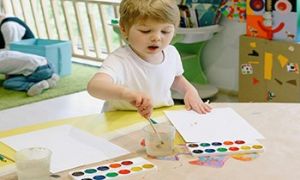A: The essence of reflection lies in its depth and authenticity—a well-articulated reflection can transport the reader into the moment, spark emotions, and leave lasting lessons. The joy of learning, perseverance, discovery, and growth breathe life into the concept of reflection, the kind that celebrates the humanity and unpredictability of education and development. It’s not about ticking boxes; it’s about telling tales of triumphs, struggles, and the endless curiosity that fuels progress. Here are some ideas to make reflections more inspiring and impactful:
Here are some ideas to make reflections more inspiring and impactful:
Personal Anecdotes: Encourage reflections that include stories of specific moments—like a child overcoming a challenge, discovering a new passion, or making a breakthrough.
- Include moments like a child's “light bulb” moment or when they tackled a seemingly hard problem. For example, "Maria struggled with this puzzle for a few days, but today, she solved it on her own and beamed with pride."
- Use vivid, sensory details to make the story come alive—what was seen, heard, or felt in that moment?
Celebrating the Joy of Learning: Share moments that capture students' excitement, curiosity, or delight when they grasp a new concept or create something meaningful.
-
Highlight moments of excitement, like when a student exclaimed, "I did it!" after finishing a difficult task.
- Talk about quirky, joyful moments—like a science project gone hilariously wrong but sparking unexpected curiosity.
Failure as Growth: Highlight instances where not achieving something led to valuable lessons, resilience, or a new approach.
- Reflect on how students approached their struggles: When Anil's experiment failed, he didn’t give up. Instead, he asked, ‘What can I change?’ That determination led to his success the next day.”
- Frame setbacks as stepping stones to insight, showing resilience and critical thinking.
Children's Voices: Include quotes or observations from students themselves about their experiences or growth.
- Incorporate direct quotes like “I loved building this because it was so hard for me but I did it."
- Let their words convey their perspective. Sometimes, it’s the simplest phrases that reveal the most.
Creative Formats: Experiment with formats—poetic reflections, visual journals, or video diaries—to make reflections engaging and personal.
- Try writing reflections in free-verse poetry or as letters to future students.
- Experiment with digital formats like interactive slideshows or video clips capturing moments of learning.
Unexpected Connections: Discuss how a learning experience tied into a broader life moment or interdisciplinary insight.
- Show how a lesson is intertwined with a personal passion or real-world event—"When we studied ecosystems, Aditi shared how she started composting at home to reduce waste."
- Link classroom learnings to broader themes like empathy, teamwork, or global issues.
Small Wins: Focus on those seemingly ordinary yet extraordinary moments of progress.
- Celebrate little triumphs like, "Today, Rohan tied his shoelaces for the first time. He said, 'Now I can run without tripping'!"
- Focus on those quiet yet meaningful moments that are often overlooked.
Sample Reflection
Here’s a sample reflection that focuses on personal anecdotes, failure as growth, and celebrating joy in learning:
Today, I witnessed a heartwarming moment as Arjun discovered how to stack blocks in a way that made his tower taller than ever before. At first, he struggled with balancing the blocks, and his tower would topple each time he added a piece. “It keeps falling!” he exclaimed with a hint of frustration.
But then, something incredible happened. Arjun paused, looked carefully at the blocks, and started adjusting the way he placed them. With each attempt, his confidence grew, and finally, his tower stood tall. He jumped up with excitement, clapping his hands, and said, “I did it! Look how big it is!”
Arjun’s determination and problem-solving skills were inspiring. It was a wonderful reminder of how perseverance and hands-on exploration lead to joyful learning moments. Watching him take pride in his achievement was truly a highlight of the day!
What's Next
Once you've written the reflection, here are some meaningful steps you can take:
-
Review and Refine: Check for clarity, emotional resonance, and authenticity. Ensure the reflection captures the moment and aligns with its purpose—whether to inspire, inform, or evaluate.
-
Share It: Consider sharing the reflection with the intended audience:
- Parents: Send it home as part of a progress update, celebrating the child’s growth and milestones.
- Colleagues: Use it as an example of effective reflection or spark a discussion on best practices.
- Documentation: Include it in the child’s learning portfolio or classroom journals.
-
Connect It: Reflect on how the insights gained can shape future actions.
- Adjust lesson plans to foster perseverance or curiosity.
- Create opportunities for the child to build on their strengths or overcome similar challenges.
-
Inspire Others: Use the reflection to encourage storytelling and authentic reflections among your team, making it a model for thoughtful, inspiring writing.
-
Celebrate the Child: If appropriate, share the story with the child. Recognizing their effort and celebrating their achievement can boost confidence and enthusiasm for learning.
Further Reading
Reflective Practices In Childcare
Educators Guide To Critical Reflections
A Guide To Writing A Daily Reflection
Critical Reflections In The Assessment and Rating Process
How To Write Critical Reflections
Q: How Can Educators Make Reflections Meaningful?







 As an Educator in Australia, your pay rate falls under the Children’s Services Award 2010. This award states the minimum amount that an employer can
As an Educator in Australia, your pay rate falls under the Children’s Services Award 2010. This award states the minimum amount that an employer can When working as a qualified Early Childhood Teacher (with a university degree) within a service, your rate of pay will come from the Educational Services
When working as a qualified Early Childhood Teacher (with a university degree) within a service, your rate of pay will come from the Educational Services When working as a Diploma Qualified Educator your pay rate is from the Children's Services Award 2010. This Award states your minimum rate of pay
When working as a Diploma Qualified Educator your pay rate is from the Children's Services Award 2010. This Award states your minimum rate of pay When working as a Cert 3 Qualified Educator, your pay rate is from the Children's Services Award 2010. This Award states your minimum rate of
When working as a Cert 3 Qualified Educator, your pay rate is from the Children's Services Award 2010. This Award states your minimum rate of Educational Leaders play a crucial role in their early childhood service by ensuring that the educational program aligns with best practices and supports the holistic
Educational Leaders play a crucial role in their early childhood service by ensuring that the educational program aligns with best practices and supports the holistic In early childhood education and care, ratios are more than a technicality—they are a frontline safeguard. Every child deserves responsive supervision, emotional connection, and developmental
In early childhood education and care, ratios are more than a technicality—they are a frontline safeguard. Every child deserves responsive supervision, emotional connection, and developmental With the new national child safety reforms kicking in on 1 September 2025, early childhood services like yours have a real opportunity to lead the
With the new national child safety reforms kicking in on 1 September 2025, early childhood services like yours have a real opportunity to lead the Here’s a comprehensive Mobile Phone and Smart Watch Policy tailored for early childhood education and care (ECEC) services in Australia, aligned with the latest 2025
Here’s a comprehensive Mobile Phone and Smart Watch Policy tailored for early childhood education and care (ECEC) services in Australia, aligned with the latest 2025 The Sea of Fish Challenge is a national initiative that invites children, educators, families, and communities to create and display fish artworks as a symbol
The Sea of Fish Challenge is a national initiative that invites children, educators, families, and communities to create and display fish artworks as a symbol Across the early childhood education and care sector, educators are sounding the alarm: current staffing ratios are insufficient to deliver safe, meaningful, and developmentally appropriate
Across the early childhood education and care sector, educators are sounding the alarm: current staffing ratios are insufficient to deliver safe, meaningful, and developmentally appropriate


